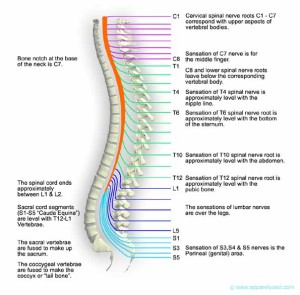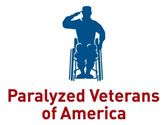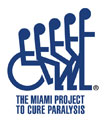A Look at the Spinal Cord and Spinal Cord Injury
Recent estimates in the United States indicate that there are between 250,000–400,000 people living with some type of spinal cord injury (SCI) or disorder that significantly affects their life activities. Over 13,000 more people in the U.S. alone sustain injuries every year. That means that every 41 minutes, someone new sustains a spinal cord injury. More than half of those who are injured are between 16 and 30 years old. Vehicular accidents cause 47.5% of these spinal cord injuries. 13.8% are the result of violence and 22.9% are the result of falls. Sports injuries account for 8.9% of these injuries. 79.6% of SCI individuals are male and approximately half are married at time of injury. On a more positive note, the majority (90%) of SCI individuals survives and lives near-normal life spans.
Mike Savicki’s story is a perfect paradigm for these statistics. On a sunny Saturday morning in early November 1990, Mike waded out into the waters of Pensacola Beach. As a wave came towards the shoreline, he dove under it. The wave broke a bit early, pushed his head down and caused a compression fracture in his neck. His body couldn’t absorb the downward force of the wave and the violent movement of his body hitting the sandy bottom. Mike broke his neck. The strange feeling of pins and needles passed through his entire body and didn’t subside until most of the movement had left his body. He never felt even an ounce of pain.
Over the next few minutes, he remained conscious but was floating upside down unable to move much more than his shoulders, neck and a portion of his arms. While the safety of the beach and the availability of fresh air was only a few yards away, it might as well have been somewhere over the horizon. He couldn’t move nor could he swim towards shore. He was barely able to lift his head for small breaths of air and was at the mercy of the waves to push him to safety. Minutes passed and when his friends noticed him in the tide wash they called for help. He was lucky that they didn’t try to move him as this might have caused more damage to his spinal cord.
After a Life Flight to Pensacola Baptist Hospital and a series of tests and MRIs, the ER doctor told Mike he had broken C6 and C7. He was now a quadriplegic (he still has some feeling, but no movement, below his level of injury). He explained that Mike would need a manual wheelchair from that day forward, but insisted he would be able to live a full and complete life—as independently as he chose—following a grueling period of spinal cord injury rehabilitation and recovery.
While the injury marked the end of Mike’s Navy career, it opened many new doors for him. He’s always happy to tell more about what happened in the days, months and years after the halo cast was put in place, his tan faded and the bones in his neck healed.
What is the spinal cord?
The human spinal cord is a bundle of nerve cells and fibers approximately 17 inches long that extends from the brain to the lower back. It connects your brain with your muscles, skin and internal organs. Similar to a telephone line, it relays millions of messages from the brain to a specific body part. Nerve fibers pass between vertebrae and each carries a specific message to different parts of the body.
The spinal cord is the body’s superhighway for transmitting information between the brain and the nerves that lead to muscles, skin, internal organs and glands. The cord is protected by the backbone, which is made up of 33 individual vertebrae. These vertebrae have different names depending on their location. There are:
- 7 Cervical vertebrae located in the neck

- 12 Thoracic vertebrae in the upper back
- 5 Lumbar vertebrae in the lower back
- 5 Fused sacral vertebrae in the hip area
- 4 Fused vertebrae in the coccyx (tailbone)
What is Spinal Cord Injury?
Injury to the spinal cord disrupts movement, sensation and function. Paraplegia results from injury to the lower part of the spinal cord, causing paralysis of the lower part of the body. Quadriplegia (sometimes called tetraplegia) results from injury to the spinal cord in the cervical neck area causing paralysis to the lower body, upper body and arms. “Quad” means “four” so every quadriplegic has some degree of impairment in each of the four limbs. It doesn’t necessarily mean that all four limbs are paralyzed. Every year, approximately 43% of SCI is paraplegia and 57% is quadriplegia.
When a person receives an SCI, the communication between the brain and other parts of the body is disrupted and messages no longer flow past the damaged area. The extent of the communication breakdown is dependent on both the severity and location of the injury. SCI disrupts the flow along the superhighway.
SCI can occur at any level of the spinal cord, and the level of the injury will dictate which bodily functions are altered or lost. Damage to the spinal cord can cause changes in movement, feeling and other bodily functions. How many changes there are depends on where the spinal cord was injured and how severely the spinal cord was injured. The main problem with SCI is that the connection between the brain and the parts of the body below the injury is impaired. A spinal cord injury is named for the lowest level of the spinal cord that still functions the way it did before injury.
Most spinal injuries damage both upper motor neurons (UMNs) and lower motor neurons (LMNs). A complete injury cuts or squeezes all the UMNs running down the spinal cord. In a UMN injury, control by the brain no longer exists because messages from the brain can’t get through the point of injury. Though that doesn’t mean there is brain damage; it means the brain and the body no longer have the ability to share information and communicate. The LMNs act by themselves, causing reflexes without limit. LMN injuries are a different story. This kind of injury is found, for the most part, at the lower tip of the spinal cord, or the cauda equina.
How Does Recovery Work?
Immediately after a spinal cord injury, the spinal cord stops doing its job for a period of time. This is called “spinal shock.” The return of reflexes below the level of injury marks the end of spinal shock. At this time, a doctor can determine if the injury is complete or incomplete. If the injury is incomplete, some feeling and body movement may come back.
Rehabilitation begins immediately. The SCI individual will be instructed in strengthening exercises, new styles of movement, and the use of special equipment (like wheelchairs and shower benches). If additional recovery of feeling or movement doesn’t occur, a rehabilitation team will help the individual redefine and work toward new goals. Rehabilitation is a physically and emotionally difficult time, but it yields tremendous benefits. The road to recovery after SCI is different for everyone, but it’s possible to draw strength and knowledge from those who are on the same journey. If you want to learn more about SCI and organizations associated with recovery, check out the links below:
.










